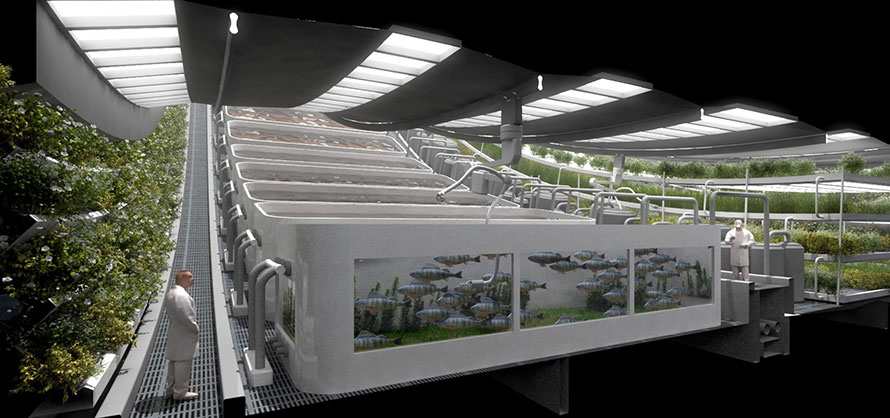People leaving Earth with the technology and tools needed to settle, survive and prosper without needing constant resupply of survival essentials from Earth.
 Cross-section of a 56-meter radius rotating aquaculture/hydroponics area. Image: Bryan Versteeg, spacehabs.com
Cross-section of a 56-meter radius rotating aquaculture/hydroponics area. Image: Bryan Versteeg, spacehabs.com
DESCRIPTION
For a community off Earth to thrive, it cannot be dependent upon a constant resupply from Earth of critical resources. Adequate self-sufficiency will be achieved by the development of technologies and techniques to enable the settlers to
(a) meet their basic needs for survival essentials such as air, water, power, shelter, basic foodstuffs, and the like by using local materials – e.g., soil, metals, ice and other volatiles, sunlight, and, in the case of Mars, atmosphere– such methods collectively often referred to as “in situ resource utilization” or “ISRU,” and
(b) maintain, repair, reuse, recycle and to some extent replicate the materials and tools that constitute the daily-living amenities that are the hallmarks of modern life, such as medicines, electronics and clothing.
In building towards that goal, off-Earth settlements will initially receive regular infusions of initial infrastructures and supplies (e.g., habitats, power generating equipment, medicines, tools and electronics) until a critical mass has been assembled. That initial assemblage will enable the community to achieve adequate self-sufficiency, with a need for only occasional imports of items for which the community has not yet been able to develop its own manufacturing base. At that stage regular two-way commerce, of both people and materials, will develop between the community and Earth and other off-Earth settlements. Such a development is often characterized as the essence of a “spacefaring civilization.”
As a community matures, it may achieve a level of self-sufficiency which could, if necessary, allow it to survive indefinitely without any further imports from Earth. It would be difficult for any community to become perfectly self-sufficient, as most communities on Earth are not, but trade of commodities between individual settlements in space may replace most of the importing from Earth. The importance of the degree of self-sufficiency for each type of physical supply depends highly on the required mass of the material needed per person per year or per industry per year.
COMPONENTS (required capacities, processes and steps)
Precursor Missions. Robotic precursor and test missions (followed by crewed missions) to do the following:
- Test a wide variety of synthetic materials for durability, toxicity, outgassing characteristics, etc, leaving them exposed to the off-Earth environment for long periods of time
- Land or rendezvous and verify the existence of raw materials at mining sites.
- Characterize the environment of possible settlement and mining sites.
Enabling Technologies. Substantial investments in a broad spectrum of enabling technologies and techniques:
- Methods and equipment for digging and drilling to expose and retrieve various raw materials (materials acquisition).
- Methods and equipment for converting rock, soil and volatile materials into pure volatiles for life support and propellants and into structural elements, in all locations, both on planetary surfaces and in space (in microgravity). This includes:
- Using local soil and solid minerals, combined with some volatiles, to create useful materials, e.g., metals, plastics and polymers, composites, ceramics, fabrics, soils).
- Methods to convert the materials into useful structural elements.
- Mechanisms to convert ice or atmospheric gases (volatiles) to potable and pure water, oxygen, plant growth media, rocket fuel, etc.
- Other relevant technologies including: manufacturing, miniaturization, nanotechnology, robotics, materials fabrication, energy use, structural design (e.g. hard shell habitats vs. inflatables), etc.
- Transportation systems for operations on planetary surfaces and in space between orbiting settlements and other locations.
- Materials for and methods of effective radiation shielding.
- Methods of dealing with the effects of lunar and Martian dust and electrostatics on equipment.
- Various power and energy sources (e.g., solar, nuclear, other), and energy storage systems.
- Communication techniques (both local and to Earth or other locations).
- Manufacturing processes in vacuum and near-vacuum.
- Manufacturing processes in microgravity and low-gravity conditions.
- Methods of agriculture and food production in microgravity and low-gravity conditions.
- Bioengineering and in-space food production.
- Recycling of air and organic materials (sometimes referred to as Controlled or Closed Ecological Life Support Systems, or “CELSS”).
Pilot Scale Operations. Pilot scale operations could prove out the processes that will be used at full scale, as described in the list of enabling technologies, before the full scale equipment is built and moved to where it will be used.
Full Scale Operations. Full scale operations would be used to actually build, maintain and operate the settlements, including any local industries.
The “ultimate” goal is to develop the full set of technologies needed to be able to turn “dead” asteroidal or surface rocks and minerals into “living,” maintainable, sustainable and adequately self-sufficient space habitats – almost anywhere.
These operations will become increasingly complex, as initially promising technologies and techniques (such as additive manufacturing) are tested on ever larger scales.
COMPLETION
This milestone will be considered achieved when a space settlement can exist with an amount of goods exchanged comparable to any city in a technically advanced country.
MORE OF THE NSS ROADMAP TO SPACE SETTLEMENT:






